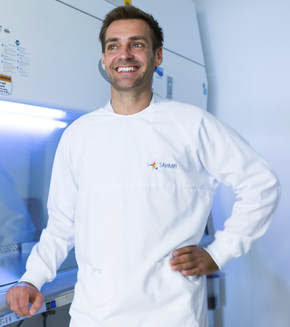How does the science work?
 Associate Professor Cedric Bardy’s (Flinders University – SAHMRI) study uses live human neurons (brain cells) in a petri dish to examine the biological basis of Parkinson’s disease. The neurons are generated in the lab with non-invasive stem cell technologies. The idea is to prevent overload of electrical activity occurring in patient’s neurons to rescue energy levels, protect further neuronal losses and halt the progression of the disease.
Associate Professor Cedric Bardy’s (Flinders University – SAHMRI) study uses live human neurons (brain cells) in a petri dish to examine the biological basis of Parkinson’s disease. The neurons are generated in the lab with non-invasive stem cell technologies. The idea is to prevent overload of electrical activity occurring in patient’s neurons to rescue energy levels, protect further neuronal losses and halt the progression of the disease.
Cedric says, “When talking to people living with Parkinson’s disease, I often hear complaints of exhaustion. This got me thinking. In Parkinson’s disease, fewer dopamine cells are left behind to do the work of thousands of cells that died too early. That creates a huge energetic burden, which we know can become damaging if not stopped. Artificially raising the energy in brain cells is not easy, but what if we could give the cells a break from too much activity? A few hours break each day, just enough to give these brain cells a chance to restore their energy levels and repair themselves from all the extra work? We could use natural venoms to our advantage to do just this. There is so much untapped therapeutic potential from natural venom peptides, and Australia is a gold mine for it. This exciting research project brings together experts from three continents (North America, Europe and Australia). Our team will test whether the right venom molecule could transiently lower midbrain dopamine neuron activity, improve cellular repair and make these precious cells last longer. It’s a long shot but if it works, a therapeutic breakthrough that can slow down neurodegeneration in Parkinson’s disease will change the lives of millions of people worldwide.”
Current Parkinson’s treatments do not help in the long-term
Parkinson’s is a challenging, incurable, degenerative condition. Symptoms may include muscle rigidity, tremor, postural instability and bradykinesia (slowness of movement). Parkinson’s does not just affect movement; other symptoms can include pain, sensory changes, changes in the gastrointestinal system, anxiety/depression, problems with memory and thinking, dementia and sleep disorders. There are over 200,000 Australians living with Parkinson’s and 10 million worldwide.
Olivia Nassaris, Executive Director THRFG – Parkinson’s says, “When Cedric first approached me with the idea of the potential to use natural venom-derived, molecules I thought it was a crazy idea, but modified toxins are already in use in blood pressure medication. By isolating and slightly tweaking these components, scientists like Cedric can use them as the basis for effective new treatments in Parkinson’s.”
Global collaboration uniting for one goal
Clyde Campbell, CEO and founder of SIUAF, is living with Young Onset Parkinson’s. SIUAF was established 10 years ago to promote and fund Parkinson’s disease research in Australia to prevent, slow, stop and cure the disease. The Foundation and its partner MJFF are the largest non-government funders of Parkinson’s research across multiple institutes in Australia.
Clyde said, “This project is highly innovative in its combination of the latest technological advances led by Cedric’s lab in electrophysiology and for genomic repair. Parkinson’s presents an immense burden on society and has been the focus of intensive research efforts, but treatments remain sub-optimal. Recent breakthroughs to generate patient-derived neuronal culture from induced pluripotent stem cells (iPSC), which Bardy’s team has pioneered, provide novel opportunities to gain insight into PD and test new therapeutic ideas pre-clinically.”
This project may reveal the underlying mechanisms of neuronal dysfunction in PD and shed light on new druggable pathways while testing an innovative approach to protect brain cells and thereby quality of life. Slowing Parkinson’s progression would have lifechanging benefits for millions of people affected globally by this disease,” said Shalini Padmanabhan, PhD, Director of Research Programs, MJFF.


